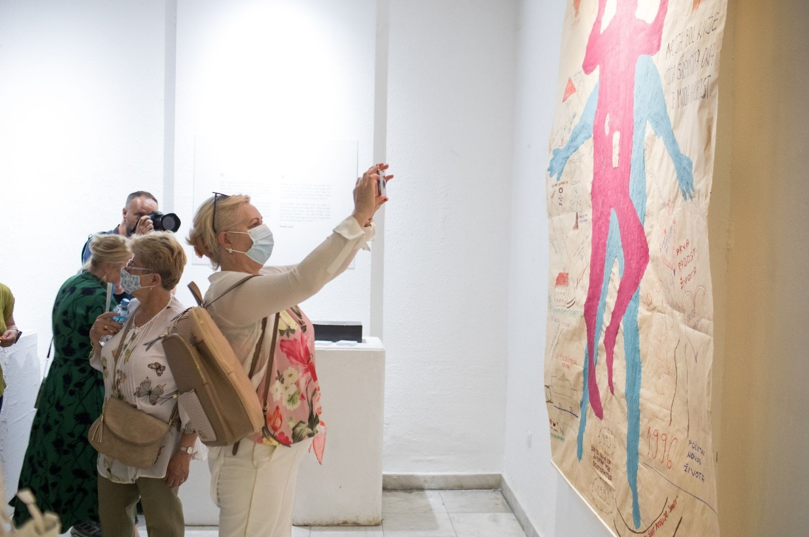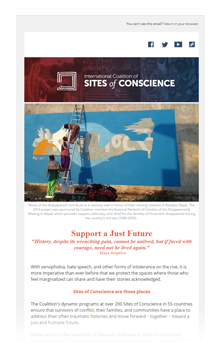Ashley Nelson, Director of Communications at the Coalition, recently spoke with Amina Krvavac, Executive Director of the War Childhood Museum (WCM), a Site of Conscience located in Bosnia and Herzegovina, about how art methodologies like body-mapping allow the Museum to offer survivors of conflict-related sexual violence an alternate language to convey the trauma of their experiences and, ultimately, foster healing.
The International Coalition of Sites of Conscience recently offered a training at WCM in body-mapping – a technique in which one tells a story through a life-sized drawing of one’s own body. Such art methodologies often provide an alternate language for survivors to convey the trauma of their experiences. Can you speak about your experience engaging with this approach and what new opportunities it provided your community?
From its very inception, the War Childhood Museum (WCM) adopted a human-centered approach in documenting and presenting personal experiences of people whose childhoods have been affected by armed conflict. In work that has involved hundreds of survivors so far, we have always paid particular attention to their well-being. We have invested a lot of effort in shielding these individuals from re-traumatization in every step of the documentation process. In line with this, we are continuously looking for innovative ways of engaging with different groups of survivors in our community.
documenting and presenting personal experiences of people whose childhoods have been affected by armed conflict. In work that has involved hundreds of survivors so far, we have always paid particular attention to their well-being. We have invested a lot of effort in shielding these individuals from re-traumatization in every step of the documentation process. In line with this, we are continuously looking for innovative ways of engaging with different groups of survivors in our community.
After learning about the Coalition’s work and expertise in body-mapping methodology, we thought that it could be a very interesting and valuable tool for our work with different interest groups. Only a few months after the training, we have conducted our first workshop with young women who survived conflict-related sexual violence in Bosnia and Herzegovina. It was the very first time that the survivors from this particular group took part in an art-based workshop offered by a local museum, and the feedback we received from workshop participants was overwhelmingly positive.
The body-mapping workshop provided the Conflict-Related Sexual Violence (CRSV) survivors with alternative means of communication about the difficult past experiences, but it also, perhaps even more importantly, enabled deeper reflection. Through this introspective process, workshop participants became more aware of their emotions and strengths, all while gaining access to their internal resources that have been buried deep inside. By contributing to individual healing processes, this workshop also paved the way for healing processes on a collective level.
After realizing the potential and beneficial effects of the body-mapping method, we plan to continue using it in our work with other interest groups in our community.
I’m curious how you plan on incorporating body-mapping into your programming, including in your work with children?
One of the results of the workshop with survivors of conflict-related sexual violence was that our collection is enriched with 12 life-sized body maps of incredibly brave young women, with whom we co-produced an exhibition dedicated entirely to their experiences. The exhibition titled “Speaking Out” aimed to give voice to CRSV survivors and to raise awareness about their position in the Bosnian and Herzegovinian society, which remains precarious even 25 years after the war. After Sarajevo, the exhibition will travel to several other cities in Bosnia and Herzegovina, as well as abroad.
A personal message from one of the survivors, which was exhibited next to her body map, read as follows:
 A: “When we talk about fighting stigmatization, I think our starting point should be our local communities. Our society is patriarchal, and this is even more pronounced in villages than in the cities. For those of us who live in smaller communities, it is a given that everybody knows our story – we are misunderstood and without support. We are also missing support from religious communities because they never publicly acknowledged that we exist and all that we’ve been through.”
A: “When we talk about fighting stigmatization, I think our starting point should be our local communities. Our society is patriarchal, and this is even more pronounced in villages than in the cities. For those of us who live in smaller communities, it is a given that everybody knows our story – we are misunderstood and without support. We are also missing support from religious communities because they never publicly acknowledged that we exist and all that we’ve been through.”
Having observed the powerful and beneficial effects of body-mapping, our plan is to incorporate this methodology in our future work with different groups, including children, and this will be done in accordance with the specific needs of each group.
Body-mapping is useful in a number of ways, namely helping survivors to express their stories and share them with others, but it can also help them envision a new future. Can you talk a bit about this in your context? What are the main value-adds, as you see them?
The body-mapping methodology is indeed beneficial in several ways, but in my view, and based on the feedback of the workshop participants from our local community, I would say that the crucial difference it makes has to do with how it enables each survivor to step out of their respective trauma and see their life in its entirety. Moreover, this means that positive experiences and events that brought joy can also be acknowledged and returned to, aiding the realization that survivors’ lives are more than their lived traumas. This realization comes with the completion of the body or rather life maps – when the survivors have the opportunity to see them, they also see just how far they came after these violent and traumatic events took place, which in turn gives, or renews, hope for the future.
 This is well illustrated through the following quotes from two workshop participants:
This is well illustrated through the following quotes from two workshop participants:
S: “I’m glad that I got reminded that I still had a happy childhood. Everything was beautiful until 1992. We went from that state of happiness to catastrophe. Now I see how strong, powerful, and fulfilled I am, and after everything that has happened to me, I still have the strength and will to pass it on to others. I help other women through my workshops. I’ve realized that we are all strong. Yesterday someone said: “We really did succeed!” This workshop has proved to me that we really did succeed.”
A: “After each workshop, we primarily think about how proud we are of ourselves. But after this workshop, I also feel content because I’ve become aware of some of the feelings that I’ve been hiding… Humiliation, fear — I fought hard not to feel these things. Now I’m aware of these feelings and I’m handling them well.”

